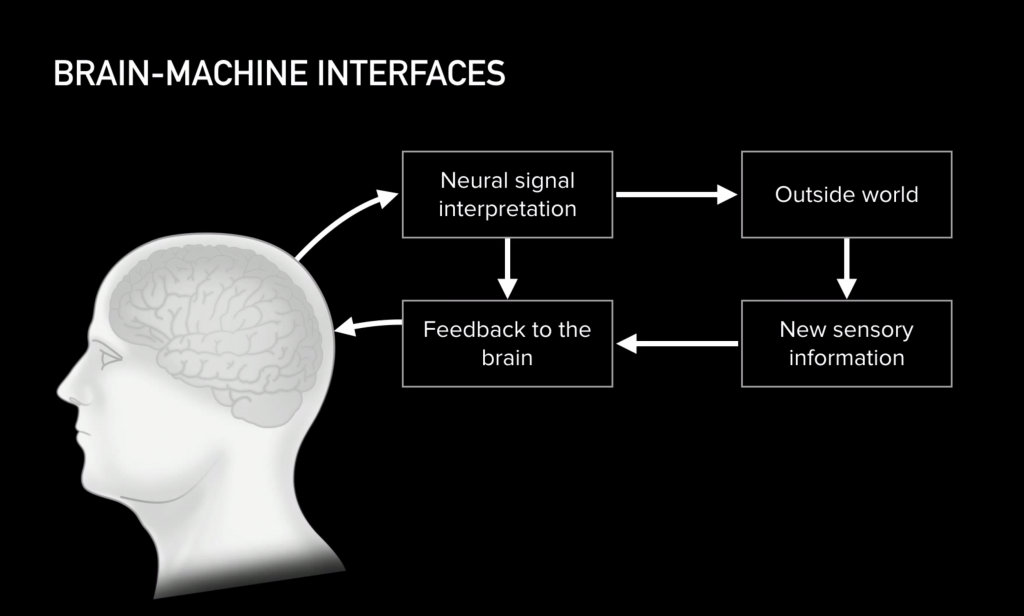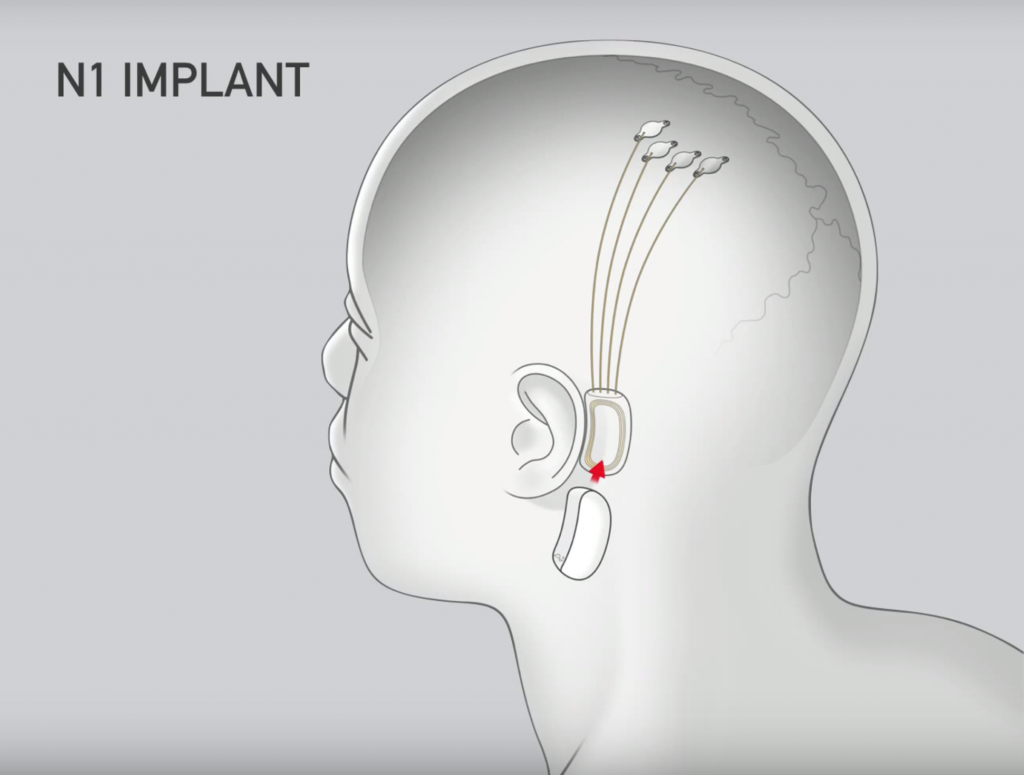Neuralink – Are Brain-Computer Interfaces leading us into a technological utopia?
Elon Musk did it again. In July 2019, the Tesla and SpaceX founder held a detailed presentation about his newest project called “Neuralink”. This startup has been developing a system that allows linking human brains directly to computers with the goal of helping people with brain and spinal cord injuries. What sounds like the newest episode of Netflix’ “Black Mirror” is actually becoming a reality. This bears the question: Are we heading towards a science revolution or science fiction?
The idea to link human brains to computer systems is nothing new (ColdFusion; Scott). Already in the 1950s, the first types of so-called Brain-Computer Interfaces (BCIs, also Brain-Machine Interfaces) were introduced. Wolpaw et al. argue that BCIs function as communication systems that don’t “depend on the brain’s normal output channels of peripheral nerves and muscles”. These systems rely on activity measured by electroencephalography (EEG) on the scalp or neuron activity recorded from implanted electrodes (Wolpaw et al.). BCIs have the potential to restore sensory and motor function as well as treat neurological disorders (Musk).
According to Joe Scott, the cochlear implant, for example, is an early-on BCI that lets deaf people hear by sending an electrical signal from an earpiece into the cochlear that goes directly into the auditory nerve. The brain then picks this signal up as sound (Scott). Now, Neuralink is supposed to bring the development of BCIs to a whole new level.

Source: YouTube, screenshot from Neuralink Launch Event
What is Neuralink?
Elon Musk introduced Neuralink already back in 2017, but only in July 2019, the billionaire shared what his newest company had been up to. Musks short-term goal is to develop a BCI that gives communication access and mobility to people with permanent spinal cord injuries (Seeker; Shankland). In the long run, he even envisions a future where BCIs will enable a symbiotic relationship between humans and artificial intelligence (AI) (Etherington; Livni).
Source: YouTube, Neuralink
How does it work?
The human brain consists of neurons that fire through synapses in response to electrical signals (when we see, hear, move, etc.) building up tiny electromagnetic fields that are called action potentials. Neuralink is supposed to tap into these electromagnetic fields and record and interpret the data (ColdFusion; Scott).
To be able to detect these action potentials, tiny threads with electrodes (about the size of 1/10 of a human hair) are developed to be inserted into the brain. Each one of these threads is infused by a remotely operated neurosurgical robot (Etherington; Musk; Timmer). The robot’s needle for insertion is about 24 microns in diameter which is much smaller than the state of the art for Deep Brain Stimulation (DBS) (Scott). According to ColdFusion, such surgeries have been done before for DBS for Parkinson’s sufferers with about ten electrodes and a much bigger needle. However, these traditional methods have a 1 in 100 chance of causing a severe brain haemorrhage. Neuralink doesn’t only reduce the risk of causing damage to the brain by using tiny threads, it also introduces the possibility of collecting vast amounts of data by using not only ten but several thousand electrodes (ColdFusion; Shankland).
The data collected by these threads are read, amplified, digitised and processed in the so-called N1 chip before being sent to a pod device located behind the ear. Unlike it is the case with older BCIs, this small, battery-powered computer is able to communicate wirelessly with the implanted chip, removing the chance of getting a dangerous brain infection through an open hole in the skull (Seeker). Detected signals will be sent from the N1 chip via Bluetooth to the pod device behind the ear and controlled with a device (phone, mouse or computer keyboard) (Timmer).

Source: YouTube, screenshot from Neuralink Launch Event
Fields of usage
Right now, Neuralink is focused on the motor cortex, the part of the brain that sends signals down to the spinal cord and onto the muscled to drive movement (Timmer; Tournas and Johnson). In the future, the same technology could be applied to other parts of the brain such as the visual cortex or auditory cortex (Scott). With this kind of development, things like depression or chronic pain could be cured or cognitive function, as well as the memory, could be increased (ColdFusion). However, it is important to note here that these are still speculations that lie in the far future if at all.
Problems Neuralink is facing
Neuralink, while introducing a whole new level of possibilities in the realm of technology, faces several issues in its development. Before being able to test such an implant on a human brain, Neuralink is currently being tested on rats and monkeys which can be seen as controversial (ColdFusion; Shankland). Furthermore, the whole concept of linking human brains to computers and possibly creating a “superintelligence” or an AI bears the question of whether this is ethical. And what about the risks for patients? Although Neuralink is less risky compared to DBS and other such procedures, we still don’t know yet what this kind of technology could lead to in its final form. And even if we find answers to these questions, there will still be financial issues: Who will be able to afford this kind of technology? Will it be exclusive for the wealthy?
However, while all these issues certainly need to be addressed in time, the probably biggest hurdle that Neuralink is currently facing is getting approval from the Food and Drug Administration (FDA) to make testing the BCI on human brains possible in the first place (Livni; Mehta; Tournas and Johnson).
A science revolution or science fiction? Only time will tell
While Neuralink introduces a greatly improved piece of technology with admirable goals, it is important to keep the risks and issues that yet need to be resolved in mind. It is impossible to predict today what will happen if Neuralink or a similar technology that connects the human brain with technological devices on such a large scale does get developed.
However, we do have the chance of learning more about how the brain works with the help of Neuralink. Plus, over time, it can be developed so that the risks will be reduced even further and the procedure will be safer. In today’s modern world it would be a shame not to use this opportunity and at least find out what is in the range of possibility by exploring what this kind of technology can lead to.
References
ColdFusion. “Neuralink – Merging Brain and Machine.” YouTube, 19 Jul. 2019, www.youtube.com/watch?v=9uRK8Delzvk. Accessed 20 Sep. 2019.
Etherington, Darrel. “Elon Musk’s Neuralink looks to begin outfitting human brains with faster input and output starting next year.” TechCrunch, 17 Jul. 2019, www.techcrunch.com/2019/07/16/elon-musks-neuralink-looks-to-begin-outfitting-human-brains-with-faster-input-and-output-starting-next-year/. Accessed 18 Sep. 2019.
Livni, Ephrat. “Elon Musk wants to put an AI interface in your brain. Should you be worried?” Quartz, 21 Jul 2019, www.qz.com/1671286/elon-musks-neuralink-is-trying-to-put-an-ai-chip-into-your-brain/. Accessed 19 Sep. 2019.
Mehta, Ivan. “Elon Musk’s Neuralink is building tech to control computers with your mind.” The Next Web, Jul 2019, www.thenextweb.com/science/2019/07/17/elon-musks-neuralink-can-read-a-rats-brain/. Accessed 17 Sep. 2019.
Musk, Elon. “An integrated brain-machine interface platform with thousands of channels.” bioRxiv, 18 Jul. 2019, www.biorxiv.org/content/10.1101/703801v2.full. Accessed 20 Sep. 2019. DOI: 10.1101/703801
Neuralink. “Neuralink Launch Event.” YouTube, 17 Jul. 2019, www.youtube.com/watch?v=r-vbh3t7WVI. Accessed 17 Sep. 2019.
Scott, Joe. “What Really Matters About Neuralink.” YouTube, 22 Jul 2019, www.youtube.com/watch?v=W_diJS6ILIA. Accessed 20 Sep. 2019.
Seeker. “Why Elon Musk Wants to Implant an Electrical Wire in Your Brain.” Elements, season 4, episode 77, YouTube, 8 Aug. 2019, www.youtube.com/watch?v=VIWaIJllptc. Accessed 20 Sep. 2019.
Shankland, Stephen. “Elon Musk says Neuralink plans 2020 human test of brain-computer interface.” CNET, 17 Jul. 2019, www.cnet.com/news/elon-musk-neuralink-works-monkeys-human-test-brain-computer-interface-in-2020/. Accessed 19 Sep. 2019.
Timmer, John. “Elon Musk’s Neuralink: Both an evolution and a plan for radical change.” Ars Technica, 13 Aug. 2019, www.arstechnica.com/science/2019/08/elon-musks-neuralink-both-an-evolution-and-a-plan-for-radical-change/. Accessed 19 Sep. 2019.
Tournas, Lucille M. and Walter G. Johnson. “Elon Musk Wants to Hack Your Brain.” Slate, 5 Aug. 2019, www.slate.com/technology/2019/08/elon-musk-neuralink-facebook-brain-computer-interface-fda.html. Accessed 19 Sep. 2019.
Wolpaw, Jonathan R. et al. “Brain-Computer Interface Technology: A Review of the First International Meeting.” IEEE Transactions on Rehabilitation Engineering, vol. 8, no. 2, June 2000, www.citeseerx.ist.psu.edu/viewdoc/download?doi=10.1.1.331.2636&rep=rep1&type=pdf. Accessed 17 Sep. 2019. DOI: 10.1.1.331.2636



